Case Study: How to Survive a Cholera Epidemic
Created by Shannan Muskopf for AP Biology | Google Doc

Part I – It’s in the Water!
The villagers were not unfamiliar with the seasonal disease that would come with the rains, though most did not understand the underlying cause. The symptoms were always the same, a quick onset of very watery diarrhea. As much as a liter of water would be lost every hour and the person would become dehydrated, eyes sunken and unable to eat. There was even a name for this specific type of diarrhea, “rice-water stool,” because it resembled water in which rice had been rinsed. Children were the most vulnerable, and many would die each year from this dreaded disease: cholera.
Out of desperation, many villagers would wear masks or avoid contact with the sick, but such efforts were often ineffective, they would still get sick. This year was different, this year, a group of scientists from Europe arrived to help. They told the villagers to give the sick people a mixture of water, sugar, and salt. They investigated the communal well that was the main source of water.
The villagers were surprised when the scientists poured some kind of a liquid into the well, which they said was medicine. Some of the villagers were afraid and refused to drink the water, instead drawing from a nearby well, they even drained the original well that the foreigners had added the treatment. The Europeans returned to find that the villagers were using water from other nearby untreated wells, so they also placed the chemical in those, and to other wells they poured a purple dye to discourage people from drinking the water there. The villagers were forced to drink from the treated well.
After a few days, people in the village stopped getting sick. Did the chemical poured in the well did help stop the spread of the disease? * Note: This case is fictional, but similar events did take place in India in 1926 (Hausler, 2006, pp. 84–85)
1. Consider actions taken by a foreign entity on the village. What ethical issues does imposing a treatment on the villagers without their consent raise? What steps could they have taken that would have made the situation more acceptable?
2. When is it appropriate to force a “cure” on a population? Remember that in North America many cities put fluoride in the water to prevent tooth decay.
What’s In the Water?
Cholera is caused by a bacteria: Vibrio cholerae is a comma-shaped bacteria with a single flagellum, and is classified as a gram negative. It is typical of most prokaryotes structurally. Not all V. cholerae cause disease, but the ones that do can cause serious diarrhea and vomiting hours after injection. During infection, the bacteria colonize the small intestine and use their pili to attach to the host cells. Not all those who get infected get sick, and some only suffer mild symptoms
3. Label the bacterium (pili, nucleoid, ribosomes, flagellum, cell membrane, cell wall)
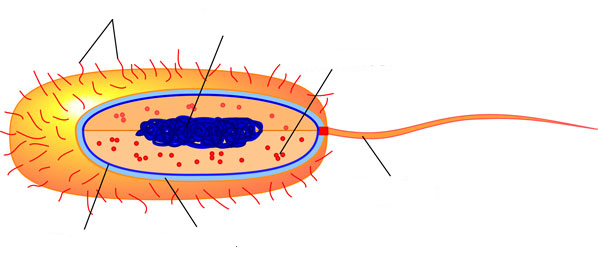
The cholera toxin is a protein built from a specific DNA sequence found on pathogenic cholera bacteria. The toxin, also known as choleragen or CTX, is composed of six protein subunits, one of those proteins, CTB, binds to receptors on the cells of the small intestine and activates cyclic AMP, which is a messenger molecule. The activation of cyclic AMP causes chloride ion channels to open and move out of the cell and into the lumen. These extra chloride ions attract sodium ions, increasing the number of ions in the lumen. This lowers the water potential, causing water to move down the concentration gradient and leave the cells, a process you might be familiar with: osmosis. This massive loss of water manifests in the patient as watery diarrhea.
4. Read the description above which describes how CTX works. Biologists often create models to help them understand processes that are difficult to visualize. Create a model (sketch) showing how V. cholerae causes diarrhea. The model should be detailed and can include annotations. Your goal is to help someone else understand what is happening.
How Do You Treat the Infected?
Treatment of cholera involves replacing the lost fluids and ions. Health care professionals can use IV’s to administer fluids or encourage the patient to drink water mixed with glucose and salt. Glucose can help provide energy for victims who have not been able to keep food down, and the salt will help cells restore their homeostasis.
5. Refresh your memory on the digestive system. On the image, identify each of the following and place an X in the area that is associated with the symptoms of cholera. [ Stomach | Large Intestine, Small intestine (duodenum) | Small intestine (jejunum) | Appendix )
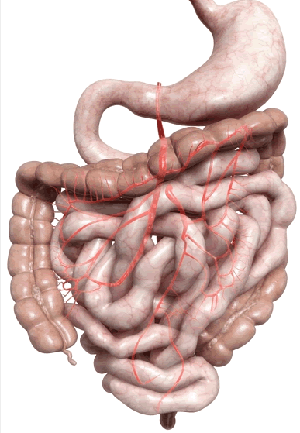
Some people can be exposed to cholera and not become infected. Differences in pathogenicity may be related to the cell membrane and channels that allow the movement of chloride and sodium ions. Those with variations in those transport proteins may be resistant to the effects of the toxin. In fact, a mutation in a gene that codes for a membrane transport protein (CFTR) is responsible for the genetic disease cystic fibrosis. In humans, this disease causes mucus to build up in the lungs, making it difficult to breathe. Some scientists suggest that the mutation persists in the population due to a phenomenon called “heterozygote advantage,”, where being a carrier of a disease gives you an advantage. For example, heterozygotes for sickle cell disease are resistant to malaria, but do not suffer the effects of the disease.
6. If heterozygote advantage is occuring with CF, in which populations would you expect to see more individuals with the CF gene. Why?
7. Suggest a way that the cholera toxin could be used as a therapy for those with CF?
Part II – Was the Water Contaminated?
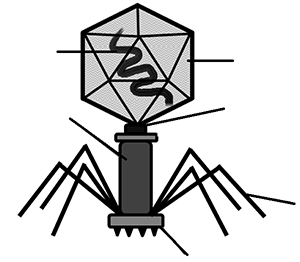
When the Europeans put a chemical in the well, what they were trying to do was to “infect” the cholera bacteria. All living things in nature are preyed upon, and that includes bacteria. In fact, bacteria have very tiny enemies called bacteriophages. Phages are not technically alive, they don’t need energy and they can’t reproduce on their own. They can invade a bacteria and hijack the cell to force it to produce more phages. This infection is deadly to the bacteria.
A bacteriophage is composed o f genetic information (RNA or DNA) enclosed in a protein capsule. It is shaped like a moon lander and has three distinct regions. The head contains the genetic material surrounded by a protein coat called the capsid. The neck and helical sheath are also composed of proteins and serve as a conduit for injecting the genetic material into a bacterium – like a syringe. Just below the head is the body of the virus which sits on a base plate and has leg-like extensions called tail fibers used for docking onto a bacteria.
The proteins making up the base plate and tail fibers have a three dimensional shape that make each unique. Phages are specific for the bacteria they infect because the proteins must fit receptors on the cell surface, like a lock and a key. Attachment of the phage occurs when the proteins match the receptors on the cell surface. Penetration occurs when the DNA of the phage enters the host cell. Once inside the cell, biosynthesis occurs, where the phage DNA replicates and the host cell produces proteins that will be used to build more phages. In the last stages, the phage particles are assembled and then are released from the host bacterium, a process called lysis that destroys the host. New phages can then go infect new hosts.
8. Use the underlined structures in the first paragraph to label the bacteriophage. Why are bacteriophages (and viruses) not considered to be living organisms?
9. Annotate the image below to describe the steps of infection by a phage using the underlined words above and number them to indicate the correct order.
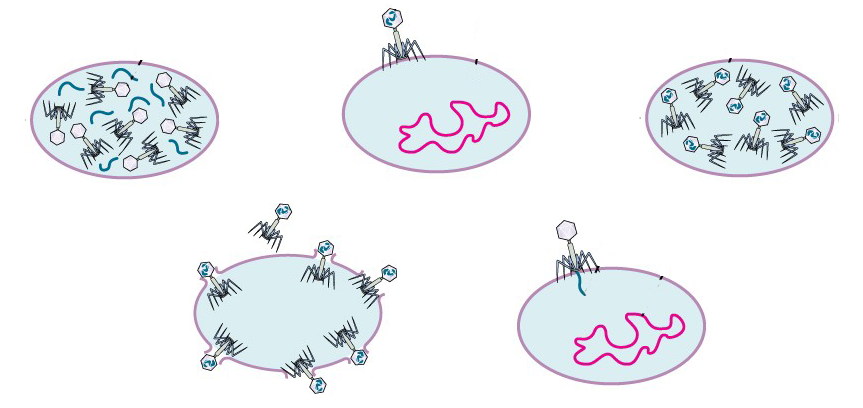
The cycle illustrated is called the lytic cycle because it results in the production of new viruses. Sometimes viruses follow another path, called the lysogenic cycle. In this case, the viral genome integrates into the host DNA but remains dormant. Each time the cell divides, it carries with it that dormant piece of viral DNA. At some point, the viral DNA will activate and the cell will switch to the lytic pathway and produce more phages. The lysogenic cycle also occurs with human viruses. For example, herpes can remain dormant in your skin and then become activated, producing a cold sore. We don’t always understand the reasons for this activation, but it usually never fails that you will get a cold sore the day before pictures or prom.
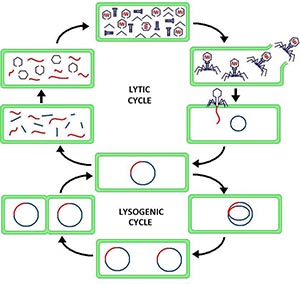
10. Would the villagers need to drink repeatedly or only once from the treated wells to obtain a sufficient dose to serve as a cure? What is the basis of your answer?
11 . Should the villagers be concerned that this bacterial virus will be harmful to their own cells? Why or why not?
12. Explain the difference between the lytic cycle and the lysogenic cycle. What would be the effect on treatment if the bacteriophage that was poured into the wells adopted a lysogenic life cycle?
Part III – What About Antibiotics?
Phages were an interesting phenomenon that did not get as much attention due to the development of antibiotics. Cholera became easily treatable with antibiotics and the idea of using phages to control infection lost favor. Antibiotics work by damaging parts of the cell that humans don’t have, such as the cell wall. Some bacteria are naturally resistant to antibiotics, which poses a problem for their long term use. When antibiotics are used, those bacteria that are resistant are more likely to survive. They reproduce and create a new generation that is also resistant. Over time, antibiotics lose their effectiveness. The rise of antibiotic resistant strains of bacteria is a major concern for modern day scientists.
The graph shows the result of an experiment where the growth of a bacterial population was monitored over time. Growth was monitored by measuring the turbidity of the culture (the more turbid a culture, the more cells are present). At 1 hour, the bacteria were divided into 4 different flasks. The bacteria in each of these flasks were subjected to different treatment (see below), and the bacteria were incubated and their growth monitored.
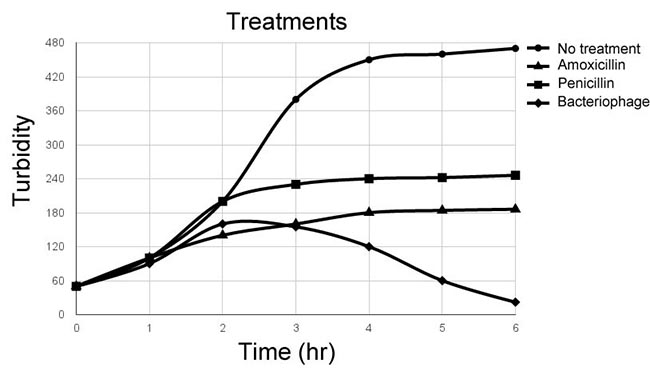
13. Which treatments were the least effective? Which were the most effective?
14. Use of antibiotics can shorten the course of the disease. Patients can be given antibiotics orally in addition to rehydration protocols. Patients may start to feel better after a day, but they should still take the antibiotics. Why?
15. Do you think cholera may become resistant to phages? Why or Why not? In your answer, consider the differences between phage therapy and antibiotics.
 Final Individual Essay: Consider the title of this case. Formulate a free response that answers the question, using details from this case. There are actually multiple answers, synthesize the major points of the case.
Final Individual Essay: Consider the title of this case. Formulate a free response that answers the question, using details from this case. There are actually multiple answers, synthesize the major points of the case.
References
An Infectious Cure - National Center for Case Study Teaching in Science. (2018). Sciencecases.lib.buffalo.edu. Retrieved 27 January 2018, from http://sciencecases.lib.buffalo.edu/cs/collection/detail.asp?case_id=608&id=608
Azimi, A. (2018). “Cystic fibrotics could survive cholera, choleraics could survive cystic fibrosis”; hypothesis that explores new horizons in treatment of cystic fibrosis. Retrieved 27 January 2018, from
Big Picture. (2018). Big Picture. Retrieved 27 January 2018, from https://bigpictureeducation.com/biology-behind-cholera
Cholera. (2018). En.wikipedia.org. Retrieved 27 January 2018, from https://en.wikipedia.org/wiki/Cholera
Jensen, M., Faruque, S., Mekalanos, J., & Levin, B. (2006). Modeling the role of bacteriophage in the control of cholera outbreaks. Proceedings Of The National Academy Of Sciences, 103(12), 4652-4657. http://dx.doi.org/10.1073/pnas.0600166103
Rodman, D., & Zamudio, S. (1991). The cystic fibrosis heterozygote — Advantage in surviving cholera?. Medical Hypotheses, 36(3), 253-258. http://dx.doi.org/10.1016/0306-9877(91)90144-n
Concepts Addressed
Virus
Bacteriophage
Bacteria
Cyclic AMP
CTX (cholera toxin)
Water Potential
Osmosis
Cell Membrane
Pathogenicity
Digestive System
Lytic
Lysogenic
Genetic Material (DNA and RNA)
Protein Capsule
Transport Proteins
Cystic Fibrosis
Heterozygote Advantage
Antibiotics


